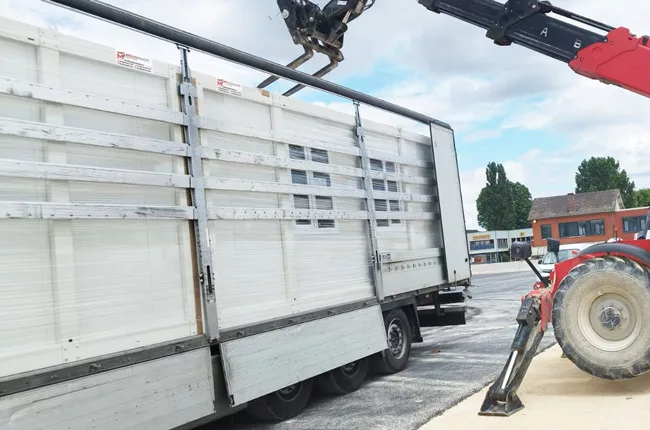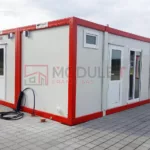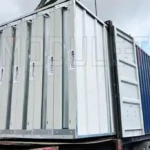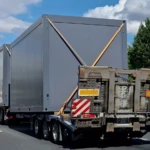Introduction – Anticipation, the key to a smooth construction site
Whether it's a base camp bungalow, a temporary office, or a sanitary module, installing a construction site bungalow is a strategic step. Often, buyers focus on choosing the model and its interior fittings, but underestimate the logistics required to set it up.
However, transportation, delivery, and implementation directly affect the smooth running of the rest of the project. Poorly prepared site access, delayed crane operations, or unstable terrain can lead to additional costs and unforeseen delays.
At MT Bungalow, we know that a successful installation begins long before the truck arrives. That's why we're offering this comprehensive guide to help you understand the steps, anticipate constraints, and ask your supplier the right questions.
1. Understand the different methods of transportation
The transport of construction site bungalows depends on several parameters: the size of the module, its weight, the distance to be covered and the accessibility of the site.
Flatbed truck
Flatbed trucks are one of the most common methods for transporting single-unit bungalows or kit-type modules. Loading is usually done using a forklift or handling equipment at the departure site, and the bungalow is then strapped down to prevent any movement during transport.
This type of transport is suitable when:
- The modules are of standard dimensions.
- Access to the site is clear and does not require complex lifting.
Crane truck
The crane truck combines transport and lifting. It allows the bungalow to be placed directly in its final location, even if it is several meters from the access point.
It is particularly recommended when:
- The site is difficult to access.
- The module must be installed high up or behind an obstacle.
- Deadlines are tight and handling must be limited.
Multi-module transport
For a prefabricated building made up of several modular bungalows (for example a base camp of 10 modules), several round trips must be planned.
As the Jamart website explains, a construction of 10 modules often requires precise timing between deliveries and crane operations to avoid congestion on site.
2. Logistical constraints to anticipate
Delivering a modular bungalow is not a simple formality. It requires a careful analysis of traffic, parking, and lifting constraints.
Accessibility of the site
First and foremost, you need to ensure that the site is accessible to heavy goods vehicles. This includes:
The width and bearing capacity of the access roads.
The absence of overhead obstacles (power lines, branches).
The presence of maneuvering areas for the truck.
In urban areas, traffic restrictions may limit access to certain times or impose specific routes.
Highway permit
In many cases, transport and unloading operations require a temporary permit to occupy the roadway. This process, which must be completed with the local authority, is essential to avoid any interruption to the construction site.
Crane constraints
Crane operation requires a safe space to position the crane truck and maneuver the boom. Other considerations include:
- Weight and load distribution.
- The distance between the truck and the final location.
- Weather conditions on D-day.
3. Impact on cost and time
Transportation and installation represent a significant portion of the total budget for a construction site bungalow. Several factors influence the cost:
- The distance between the supplier and the construction site.
- The number of modules to be delivered.
- The need to use a crane truck or other lifting equipment.
- Any administrative constraints (authorization for toll roads).
In terms of deadlines, a well-thought-out schedule helps prevent modules from remaining in storage awaiting installation, which ties up equipment and generates additional costs.
4. Prepare the ground for implementation
Even before the truck arrives, the land must be ready to receive the bungalow.
Soil stability
The support must be flat and capable of supporting the weight of the module. In some cases, it is necessary to create concrete pads or a slab to ensure stability.
Connections
If the bungalow is to be connected to water, electricity or a sewerage system, the inlets must be positioned and ready.
Orientation
Orientation influences interior comfort (sunlight, ventilation) and energy efficiency.
5. The checklist of questions to ask your supplier
To avoid any unpleasant surprises, here are some questions to include in your discussions:
- Does the quote include transport and lifting?
- Who takes care of the administrative procedures for the road network?
- What is the estimated delivery and installation time?
- What are the technical prerequisites for the field?
- Does the insurance cover possible damage during transport or lifting?
6. Tips for optimizing installation
An experienced supplier will be able to guide you through every step. However, here are some tips that can help you save time and reduce costs:
- Schedule delivery outside of heavy traffic periods.
- Coordinate the presence of the crane operator and technical teams on site.
- Provide temporary storage space if multiple modules are to be delivered.
7. Link with other equipment and modules
Each type of bungalow has its own installation constraints. A base camp bungalow will often require plumbing connections, a modular office can be operational as soon as the electrical connection is made, and a construction site canteen will require a hot and cold water supply.
To learn more, check out our complete guide: [How to Install a Flatpack Cabin] and discover our product pages:
8. On-site safety during implementation
The installation of a modular bungalow involves heavy technical operations: transport by heavy goods vehicle, lifting maneuvers with a crane truck, movement of machinery on the site, etc. These stages involve risks that must be controlled to guarantee the safety of all those involved.
Mark out and secure the crane area
Before any work begins, it is essential to mark out the unloading and installation area. This involves installing barriers, traffic cones, and information signs to prevent access to hazardous areas. This measure helps limit accidents and organize traffic flow on the construction site.
Presence of a security manager
In the most sensitive projects, the presence of a safety coordinator is strongly recommended. This person ensures procedures are followed, the perimeter is secure during operations, and coordinates the actions of the various trades present on site. At MT Bungalow, our technical teams can work in conjunction with this manager to ensure a smooth and controlled installation.
Inform the construction site teams
Before the big day, it is advisable to brief the workers and field teams on the progress of operations. This includes:
- The truck's arrival time.
- Access areas are prohibited during lifting.
- Instructions to follow in case of emergency or bad weather.
Good upfront communication limits risks, avoids interruptions and promotes a smooth installation.
Customer Testimonial – Successful Module Delivery in a Complex Context
To illustrate the importance of rigorous planning, here is the feedback from one of our clients, a structural works company operating in a dense urban environment.
The challenge: setting up a base camp on a landlocked site in the city center
The client needed to install eight modules to create a complete base camp (offices, restrooms, changing rooms, and a dining hall) on a small plot of land, bordering a public road, with no direct access for machinery. The schedule was tight: less than 25 days to deliver, install, and connect the units.
The solution implemented
MT Bungalow deployed a high-reach crane truck capable of placing the modules more than 15 meters from the main entrance. The schedule was adjusted to organize the delivery in two stages, with early morning crane slots, to limit disruption to the city center. A temporary road occupation permit (AOT) was obtained in advance from the town hall.
Result: zero delays, maximum customer satisfaction
Thanks to the anticipation of technical and regulatory constraints, the construction site was able to start on the scheduled date, with modules immediately operational. The client emphasizes in his feedback the fluidity of the coordination and the involvement of the MT Bungalow teams at each stage of the project.
This type of mission demonstrates the added value of expert support, capable of transforming a logistical constraint into operational success.
Conclusion – Anticipate to succeed
The transport, delivery, and installation of a construction site bungalow must leave nothing to chance. Careful preparation, effective coordination with the supplier, and proper anticipation of technical constraints are the keys to a successful installation.
By choosing an experienced partner, you benefit from end-to-end support: from the analysis of your site to the full commissioning of the module. With a well-oiled organization, your bungalow will be operational quickly, ready to welcome your teams in the best conditions.




